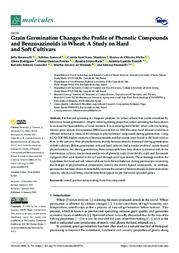Grain germination changes the profile of phenolic compounds and benzoxazinoids in wheat: a study on hard and soft cultivars.
Grain germination changes the profile of phenolic compounds and benzoxazinoids in wheat: a study on hard and soft cultivars.
Autoria: BARANZELLI, J.; SOMACAL, S.; MONTEIRO, C. S.; MELLO, R. de O.; RODRIGUES, E.; PRESTES, O. D.; LÓPEZ-RUIZ, R.; FRENICH, A. G.; ROMERO-GONZÁLEZ, R.; MIRANDA, M. Z. de; EMANUELLI, T.
Resumo: Abstract: Pre-harvest sprouting is a frequent problem for wheat culture that can be simulated by laboratory-based germination. Despite reducing baking properties, wheat sprouting has been shown to increase the bioavailability of some nutrients. It was investigated whether wheat cultivars bearing distinct grain texture characteristics (BRS Guaraim, soft vs. BRS Marcante, hard texture) would have different behavior in terms of the changes in phytochemical compounds during germination. Using LC-Q-TOF-MS, higher contents of benzoxazinoids and flavonoids were found in the hard cultivar than in the soft one. Free phytochemicals, mainly benzoxazinoids, increased during germination in both cultivars. Before germination, soft and hard cultivars had a similar profile of matrix-bound phytochemicals, but during germination, these compounds have been shown to decrease only in the hard-texture cultivar, due to decreased levels of phenolic acids (trans-ferulic acid) and flavonoids (apigenin) that were bound to the cell wall through ester-type bonds. These findings confirm the hypothesis that hard and soft wheat cultivars have distinct behavior during germination concerning the changes in phytochemical compounds, namely the matrix-bound compounds. In addition, germination has been shown to remarkably increase the content of benzoxazinoids and the antioxidant capacity, which could bring a health-beneficial appeal for pre-harvested sprouted grains.
Ano de publicação: 2023
Tipo de publicação: Artigo de periódico
Unidade: Embrapa Trigo
Observações
1 - Por padrão são exibidas publicações dos últimos 20 anos. Para encontrar publicações mais antigas, configure o filtro ano de publicação, colocando o ano a partir do qual você deseja encontrar publicações. O filtro está na coluna da esquerda na busca acima.
2 - Para ler algumas publicações da Embrapa (apenas as que estão em formato ePub), é necessário ter, no celular ou computador, um desses softwares gratuitos. Sistemas Android: Google Play Livros; IOS: iBooks; Windows e Linux: software Calibre.
Acesse outras publicações
Acesse a Base de Dados da Pesquisa Agropecuária (BDPA) para consultar o acervo completo das bibliotecas da Embrapa.

